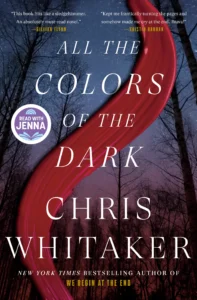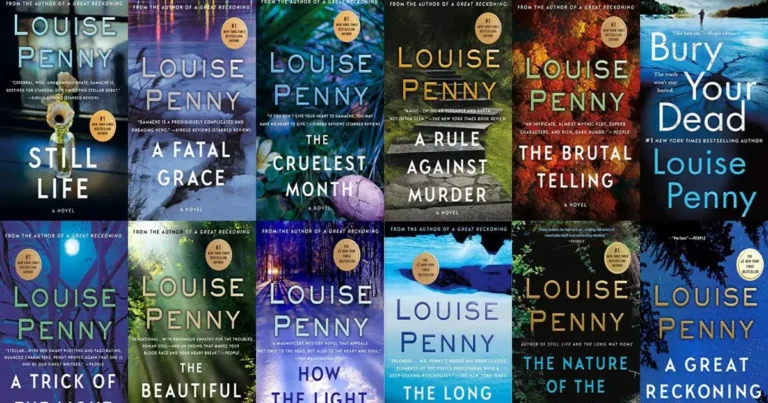All the Colors of the Dark Summary: Chris Whitaker’s Moving Tale
Chris Whitaker’s “All the Colors of the Dark” emerges as a powerful exploration of human resilience, weaving together threads of loss, hope, and unexpected connections. This remarkable novel transcends typical genre boundaries to deliver a story that resonates deeply with readers seeking authentic portrayals of healing and redemption.
The all the colors of the dark book stands out in contemporary fiction for its sensitive handling of trauma without sacrificing narrative momentum. Whitaker crafts characters who feel genuinely human—flawed, struggling, yet capable of growth and connection despite overwhelming circumstances.
At its core, this all the colors of the dark summary reveals a story about two broken individuals whose paths intersect in ways that initially seem coincidental but gradually reveal deeper connections. Through Patch and Saint’s intertwined journeys, Whitaker demonstrates how healing often comes through the most unexpected relationships.
The novel’s unique appeal lies in its refusal to offer simple solutions to complex problems. Instead, it presents a nuanced view of recovery that acknowledges setbacks while maintaining hope for transformation and renewal.
Table of Contents
Plot Summary and Key Events
The narrative centers on Patch, a young girl whose world has been shattered by devastating family tragedy, and Saint, a man carrying the weight of past mistakes that have defined his existence. Their initial encounter sets in motion a series of events that will fundamentally change both their lives.
Patch’s journey begins in the aftermath of unimaginable loss, showing her struggle to navigate a world that no longer feels safe or predictable. Her resilience becomes evident not through dramatic gestures but through small acts of survival and moments of unexpected courage.
Saint’s storyline reveals a character haunted by guilt and regret, searching for meaning in a life that seems to have lost all purpose. His path toward redemption unfolds gradually, showing how individuals can find new direction even after profound failures have seemingly closed all doors.
The all the colors of the dark by chris whitaker skillfully reveals how these seemingly separate stories converge, creating a narrative that explores the ripple effects of both trauma and healing on the human spirit.

Character Analysis: Patch and Saint
Patch’s Journey
Patch emerges as one of contemporary fiction’s most compelling young protagonists, embodying resilience without falling into unrealistic portrayals of childhood strength. Her character development shows how young people process trauma differently than adults, often finding creative ways to cope that surprise the adults around them.
Her relationship with the world shifts throughout the novel, moving from withdrawal and fear toward cautious engagement and eventual trust. This progression feels authentic because Whitaker avoids rushing her healing process or minimizing the ongoing impact of her experiences.
Saint’s Transformation
Saint’s character arc explores the possibility of redemption for those who have made serious mistakes. His guilt feels genuine and overwhelming, making his gradual journey toward self-forgiveness and purpose particularly powerful when it occurs.
The development of his protective instincts toward Patch reveals new dimensions of his personality, showing how caring for others can become a pathway to healing one’s own wounds. This relationship dynamic avoids being manipulative or overly sentimental.
Theme Exploration and Literary Significance
Trauma and Recovery
The all the colors of the dark book approaches trauma with remarkable sensitivity, showing how different individuals process loss and pain in unique ways. Rather than presenting recovery as a linear process, the novel acknowledges the setbacks and unexpected breakthroughs that characterize real healing journeys.
Whitaker’s portrayal avoids both minimizing trauma’s impact and presenting it as insurmountable. This balanced approach makes the book valuable for readers seeking realistic depictions of overcoming adversity while maintaining hope for the future.
The Power of Human Connection
The unlikely bond between Patch and Saint demonstrates how meaningful relationships can emerge from the most unexpected circumstances. Their connection develops organically, showing how genuine understanding can bridge differences in age, background, and experience.
This theme resonates throughout the narrative, illustrating how isolation—often a natural response to trauma—can be overcome through patient, consistent care and mutual support between individuals who understand suffering.
Theme Breakdown Table
| Theme | Description | Example from Story |
|---|---|---|
| Healing Through Connection | Shows how relationships can facilitate recovery from trauma | Patch and Saint’s growing trust helps both process their pain |
| Redemption and Second Chances | Explores whether individuals can overcome past mistakes | Saint’s transformation from guilt-ridden to purposeful |
| Resilience in Youth | Examines how young people adapt to traumatic circumstances | Patch’s creative coping mechanisms and gradual opening to trust |
| Finding Purpose After Loss | Investigates how meaning can emerge from devastating experiences | Both characters discover new reasons for living through their bond |
Writing Style and Literary Techniques
Atmospheric Prose
Whitaker’s writing style creates vivid atmospheres that enhance emotional impact without overwhelming the reader with excessive description. His prose serves the story’s emotional needs while maintaining clarity and accessibility for diverse reading audiences.
The all the colors of the dark by chris whitaker showcases an author who understands how to use language as a tool for emotional connection rather than mere display. His descriptive passages feel purposeful and integrated into the narrative flow.
Character-Driven Storytelling
Rather than relying heavily on external plot devices, Whitaker allows his characters’ internal struggles and developing relationships to drive the story forward. This approach creates deeper reader investment in the outcomes and makes character growth feel earned rather than imposed.
The pacing reflects the gradual nature of real healing, avoiding the quick fixes that often characterize less thoughtful approaches to trauma narratives. This patience with character development distinguishes the work from more commercially driven fiction.
Critical Reception and Literary Impact
All the colors of the dark reviews have consistently praised Whitaker’s achievement in creating emotionally resonant fiction that avoids common pitfalls of trauma narratives. Critics have noted his ability to address difficult subjects while maintaining compelling storytelling that serves both literary and popular audiences.
The novel has gained recognition from major literary publications, with reviewers highlighting Whitaker’s skill in balancing darkness and hope without minimizing either element. This critical acclaim has helped establish the book as significant contemporary fiction worthy of serious literary attention.
Professional critics have particularly praised the authentic character development and the author’s refusal to provide easy answers to complex emotional and moral questions. According to Goodreads, reader responses have been overwhelmingly positive, with many noting the book’s lasting emotional impact.
The work has been recommended by literary organizations and book clubs for its discussion potential and its sensitive handling of difficult themes that resonate with contemporary social issues.
Star Ratings Analysis
| Aspect | Rating | Justification |
|---|---|---|
| Plot Development | ★★★★☆ | Well-paced with meaningful character arcs, though some may find it slow |
| Character Depth | ★★★★★ | Exceptionally developed protagonists with authentic growth trajectories |
| Writing Quality | ★★★★★ | Lyrical yet accessible prose that enhances emotional impact |
| Theme Integration | ★★★★☆ | Thoughtful exploration of complex themes without heavy-handedness |
| Overall Impact | ★★★★★ | Memorable and emotionally significant reading experience |
Comparison to Contemporary Fiction
The all the colors of the dark book shares thematic territory with other contemporary novels exploring trauma and recovery, such as works by Colson Whitehead and Celeste Ng. However, Whitaker’s approach distinguishes itself through its focus on intergenerational healing and the specific dynamics between his two protagonists.
Unlike many trauma narratives that focus primarily on damage and its immediate aftermath, this work emphasizes the potential for transformation and growth over time. This hopeful approach makes it more optimistic than many similar contemporary novels while maintaining realistic portrayals of the challenges involved in recovery.
The novel’s blend of literary fiction elements with accessible storytelling techniques recalls authors like Kate Atkinson and Tana French, who successfully combine serious themes with engaging narratives that appeal to both critical and popular audiences.
For readers interested in exploring related themes through different literary forms, our collection of classic poetry collections includes works that examine resilience and human connection through verse.
Reader Experience and Emotional Journey
The all the colors of the dark book creates strong emotional connections through its realistic portrayal of characters struggling with profound challenges. Readers consistently report feeling deeply invested in both protagonists’ journeys, often describing the book as difficult to put down despite its heavy subject matter.
The novel’s emotional impact stems from Whitaker’s refusal to provide quick fixes or unrealistic solutions to complex problems. Instead, he shows gradual progress and realistic setbacks that mirror actual recovery processes, creating authentic reader engagement that extends beyond the reading experience.
Many readers have shared testimonials about how the book helped them process their own experiences with loss and healing, demonstrating fiction’s therapeutic value when it addresses difficult subjects with skill and sensitivity.
Book clubs have found rich material for discussion in the novel’s exploration of redemption, resilience, and the nature of healing relationships. These conversations often extend to broader questions about trauma, recovery, and social support systems.
Discussion Points for Literary Analysis
The novel raises important questions about the nature of healing and whether individuals can truly overcome devastating experiences. These themes connect to broader contemporary discussions about trauma-informed care and the role of community in recovery processes.
Whitaker’s portrayal of the relationship between Patch and Saint offers opportunities to examine how different generations approach suffering and resilience. Their interactions reveal both universal aspects of human response to trauma and unique perspectives shaped by age and experience.
The book’s treatment of redemption invites analysis of whether society should offer second chances to those who have made serious mistakes, and what conditions might facilitate genuine transformation versus mere behavioral change.
For additional resources exploring similar themes, consider our guide to contemporary fiction analysis which examines how modern authors address complex social and psychological issues.
Literary Context and Cultural Significance
The all the colors of the dark summary reveals a work that fits within contemporary fiction’s ongoing engagement with trauma, recovery, and resilience themes. The novel contributes to current literary conversations about how fiction can address difficult subjects while maintaining hope and humanity.
Whitaker’s approach reflects broader cultural shifts toward understanding trauma as a complex, ongoing process rather than a single event with clear resolution. This perspective aligns with contemporary psychological understanding while translating these insights into accessible narrative form.
The book’s success demonstrates readers’ appetite for serious fiction that addresses real-world challenges without sacrificing literary quality or emotional authenticity. This reception suggests continuing interest in works that combine entertainment with meaningful exploration of human experience.

Frequently Asked Questions
What are the main themes explored in “All the Colors of the Dark”?
The primary themes include trauma and healing, redemption through human connection, and resilience in the face of overwhelming loss. The all the colors of the dark book explores how individuals can find hope and purpose even after devastating experiences have fundamentally altered their lives. Whitaker particularly focuses on how intergenerational relationships can facilitate healing and how caring for others can become a pathway to personal recovery and transformation.
How does Chris Whitaker’s writing style enhance the story?
Whitaker employs atmospheric prose that creates emotional depth without overwhelming readers with excessive description. His character-driven approach allows internal struggles and developing relationships to drive the narrative forward naturally. The all the colors of the dark by chris whitaker demonstrates his skill in balancing literary quality with accessibility, using language that serves emotional connection rather than mere stylistic display. His pacing reflects the gradual nature of real healing processes.
Who is the book “All the Colors of the Dark” best suited for?
This novel appeals to readers who appreciate character-driven literary fiction that addresses serious themes with sensitivity and depth. It’s particularly suitable for those interested in trauma narratives that emphasize healing and hope rather than focusing solely on damage and loss. The all the colors of the dark summary shows it’s ideal for book clubs seeking discussion-worthy material and readers who value authentic emotional experiences in their fiction. However, those seeking light entertainment might find the subject matter too intense.
Finding Light in Literary Darkness
Chris Whitaker’s “All the Colors of the Dark” stands as a testament to fiction’s power to illuminate the human capacity for healing and connection. Through Patch and Saint’s intertwined journeys, readers encounter a story that acknowledges trauma’s devastating impact while maintaining faith in the possibility of recovery and renewal.
The novel’s lasting value lies not only in its literary merits but in its ability to provide insights into resilience and recovery that extend beyond the reading experience. For those seeking fiction that matters—stories that entertain while offering genuine understanding of human complexity—this book delivers profound satisfaction.
Whether you’re drawn to character-driven narratives, literary explorations of difficult themes, or simply compelling storytelling that stays with you long after the final page, the all the colors of the dark book offers an exceptional reading experience worth sharing with others who appreciate fiction’s capacity to heal and inspire.
Consider exploring our comprehensive guide to modern literary fiction for additional recommendations that combine literary excellence with emotional depth and social relevance.

Leave a Review and Help Other Book Lovers Decide
There are no reviews yet. Be the first one to write one.







